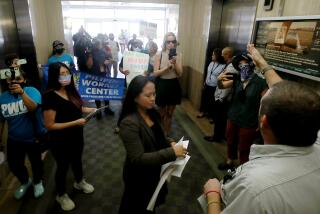Tracking the Pay Telephone Coin : Itâs No Nickel-and-Dime Operation as the Trail Winds From a Public Phone Slot to a Secret Counting Center
Whatever else may be wrong with society, people still do give a dime.
Two of them, in fact, if they are using a coin telephone for a local call.
And where, did you ever wonder, does all that phone money go?
Inside a secret location in Southern California, with 16 closed-circuit TV cameras monitoring every move, the take from those money-eating instruments gets counted every working day.
You might say the buck--420,000 of them daily--definitely stops here.
At a service station in Los Angeles, a woman in a green dress was asking no quarter, but she was giving one. It was a typical scene, little noticed, frequently repeated. The woman was inside a phone booth, making a call. Although a local call is technically 20 cents, itâs a common practice to use a quarter, because most people donât find themselves with the proper combination of required nickels and dimes.
This is the odyssey of that particular quarter:
Later in the day a van pulled up. Out stepped Debbie Jakubowski, 31, making one of about 55 such stops on her route this day.
For the last seven years Jakubowski has been a collector with Pacific Bell, one of more than 80 who cover the area from the Tehachapis to the Mexican border to the borders of Arizona and Nevada, an area that holds 78,000 coin-operated phones, which are emptied on a frequent but undisclosed schedule.
Jakubowskiâs route this day would include such mundane stops as markets, malls, a bowling alley, a hospital. There are, she discloses, livelier routes: âThere is a nudist camp that has pay phones.â
No such activity, however, at this service station. Stepping out of her van, Jakubowskiâs first move is to test the phone with a quarter, a dime, and a nickel. Had any of them not been returned after she had heard the dial tone, she would have removed the housing to see if there was a stuck coin. If so, and if she could not remove it, a repair person would be called in, showing up within 24 hours.
âThe company starts us off every day with $1.20 in change,â Jakubowski said.
Taking one of the 50-plus keys on her ring, she then opens the phone and removes a coin-filled orange receptacle inside, replaces it with an empty receptacle, all the while scribbling everything she has done onto a route sheet.
In her van is a safe with six chutes. Into one of them, its contents untouched by Jakubowski, goes the filled receptacle--including the quarter from the woman in the green dress.
Before departing, Jakubowski picks up trash inside the booth and puts it into a can in her vehicle. She checks to see that the directory is in place; had it been missing, she carries extras.
Driving to her next stop, she reflects on the various company security methods by which the collectors are carefully monitored:
âSometimes theyâll plant marked coins inside a phone, just to make sure they are returned. The markings can be seen only under a black light.
âAlso, while driving, we canât go near our own home or a friendâs home at any time. If we go somewhere for lunch, it has to be along our routes, so they can keep track of us. And, once to twice during the day, we call in to tell where we are, again so they can keep track of us.â
Jakubowski completes her appointed rounds, and heads for the coin-collection center, passing through a barred gate into the inner sanctum. Years ago there were four such centers, but the company found that having only one is more efficient. Jakubowski backs her vehicle toward No. 16 in an array of 35 vaults, and one by one unloads her receptacles onto a cart, which she pushes into a 5-by-5-foot vault, then removes a load of empty receptacles for the next day.
She then closes the vault door and departs.
On the opposite side of the vault, another worker is waiting, as the quarter deposited by the woman at the service station phone booth gets readied for its second stage of travel.
âOn an average day, we count 8 tons of quarters, 3 tons of dimes, and 1 3/4 tons of nickels,â John H. Adair said.
Adair is Pacific Bellâs public communications chief for the Southern California region. If he sees three coins in a fountain, he counts them.
His main concern, however, is pay phones. âDid you know that when you see a different type of booth, there often is a reason for it?â
For instance, at the request of Chinatown residents, many of the booths there are red.
On Olvera Street, again on request, there are brown booths.
As for where pay stations are, it might be easier to state where they arenât. âWe have one station in San Ysidro that is almost in Mexico,â Adair, 45, said. âIt is within 5 feet of the border. In fact, we have around 20 within 20 yards of the border.â
So vast is the Southern California region, that, Adair said: âI sometimes draw a dial tone from Arizona--a California booth using an Arizona area code. It is cheaper to run the dial tone wires from the Arizona office.â
Regarding pay stations in general, changes are happening, and more are on the way:
âJust this year, we installed 50 new, high-tech stations in Southern California,â Adair revealed. âThey give the customer the ability to make a coin call, to use a credit card, and to select a private long-distance carrier. We expect to have about 1,000 in place by the end of the year.â
Regardless of what is about to happen, old habits change slowly. âWe have about 4,000 charge-a-call locations,â the public communications director said. âYou cannot activate them with any money at all. Yet we find coins and currency inside the housing. Somehow people find a way to get money in them.â
From public phones in general, he went on, all manner of stuff is recovered, either from inside the set or from the coin return bucket--everything from spark plugs to gold coins.
Actually, Adair said, another change happening in some parts of the nation is the appearance of public phones that accept $1 and $5 bills.
âBut we are preferring to go the credit card route,â he added. âThe reason is that the hopper in the currency phones holds about 500 bills. There could be a problem with vandalism.â
All of this a far cry from 1878, when, according to Pacific Bell spokesman Vic Sumner, the first pay station was set up somewhere in the East. It was an âattendedâ station, meaning an operator was on hand to take the customerâs money and to place the call. Such stations often were in the foyer of the local telephone office.
The first coin machine was put into commercial use in 1889 inside a bank in Hartford, Conn.
In Los Angeles, the first pay station, an attended one, went into operation in 1898 at 228 S. Spring St., Sumner said.
And, nowadays, who uses public phones? âSome people use them exclusively,â Adair said. âEither they canât afford a private phone in their home, or they donât want one.â
On the other side of the coin, so to speak, are those who have phones in their residences--but of the coin variety. âThey pay an installation charge, and there is a monthly fee,â the phone executive said. âThere arenât many of these cases, but some of the people who do so say their kids are running up too high a bill.â
Mostly, though, coin phones are for use by the public--and there are four months when, according to Adair, they do so with the most frequency:
âThey (the phones) get the most use during the three summer months, apparently because of vacationers, and during the weeks preceding Christmas.â
October isnât one of those especially busy periods, but things are clattering at a brisk pace inside the counting room. Carol Mitchell, one of 20 data specialists who do the actual counting, is awaiting what was to be her last load of the day.
Taking one of the orange receptacles, she enters information from an attached tag into a computer, then pours its contents into a machine. Like a video game, a screen immediately begins blinking totaled amounts of the quarters, dimes and nickels.
From that machine, the phone booth coins continue into plastic bags--separate ones for the three denominations. Slugs and foreign coins are diverted into what is known as an off-sort canister.
The quarter deposited by the woman earlier in the day is in one of the plastic bags and nearing its final destination.
âThe bags travel a conveyor belt, to two extremely sensitive digital scales,â explains Mike Jungers, Pacific Bell operations manager of collection and counting.
All along the line in this secret location, as is the case with the collectors out in the field, everyone is well aware of security.
âWe have a provision that all employees know they can be searched at any time with a wand, the type such as used at airports,â Adair said.
Furthermore, Jungers added, no one is allowed to bring any loose change into the counting room. If any purse or wallet is brought in, it must be of clear plastic.
âEach filled coin bag contains $1,000, and thus if it has quarters, it must have 4,000 of them,â Jungers said. âThe required weight is just over 49 pounds.â
If a bag lacks or has so much as one coin too many, adding or withdrawing is done by hand. On this particular day, Jungers said, out of 600 bags of quarters processed, only 10 require such adjustments.
Almost like sacks of cattle feed, the bags are stacked on pallets, 25 to each.
And now comes the final leg of the odyssey, the crucial one.
âBecause, if we donât make bank deposits of our money within four days, there will be a severe coin shortage in the 11 Western states,â Adair disclosed.
âThat happened about six years ago,â Adair said. âWe were balancing our books, and the Federal Reserve called up and wanted to know where the coins were.
âIf we donât bank within four days, we have 52 tons on hand.â
On this particular day, however, the appropriate transportation shows up, and the banks get their daily feeding.
And who knows? Perhaps a certain quarter is even now back in the purse of a certain woman.
SOUTHERN CALIFORNIAâS BUSIEST PAY PHONES Locations from which the most pay phone calls are made in Los Angeles, Orange and San Diego counties are, in order:
1--Terminal One, Los Angeles International Airport
2--City and county jails
3--San Ysidro, at the U.S.-Mexican border
4--Disneyland (in vacation season)
5--Magic Mountain (in vacation season)
6--Knottâs Berry Farm (in vacation season)
7--Navy and Marine bases
8--Lindbergh Field, San Diego
9--John Wayne Airport, Orange County
10--Port of Los Angeles passenger ship terminals
Source: Pacific Bell--Public Communications
MICHAEL HALL / Los Angeles Times
More to Read
Sign up for Essential California
The most important California stories and recommendations in your inbox every morning.
You may occasionally receive promotional content from the Los Angeles Times.










